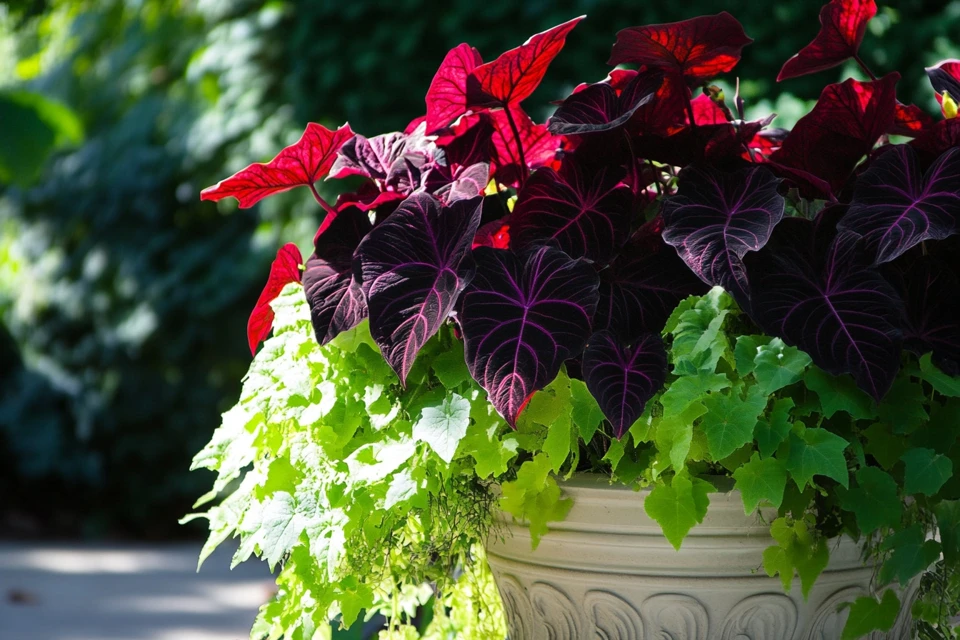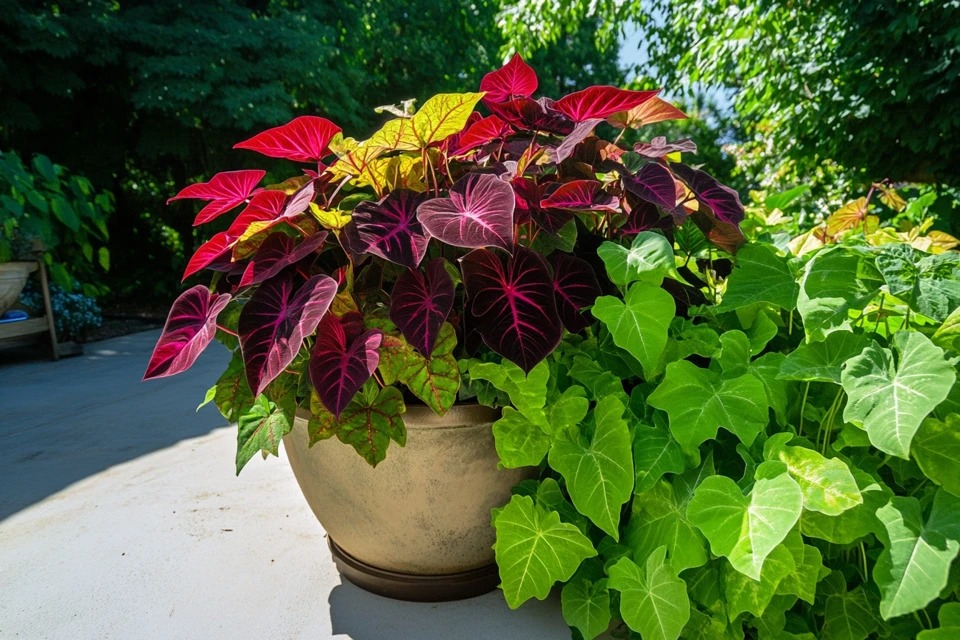Dramatic foliage has the power to completely transform a garden space, and few plants create a bigger impact than the Red-black Caladium. This absolute showstopper is famous for its large, heart-shaped leaves that boast stunning combinations of deep crimson, rich burgundy, and near-black markings.
These tropical beauties bring a touch of the exotic to shady borders, containers, and even indoor settings. This guide will walk you through everything you need to know to grow these incredible foliage plants successfully.
Understanding the Red-black Caladium
The term “Red-black Caladium” is not one specific plant, but a way to describe a whole group of caladiums that share this stunning color combination. These plants are tropical perennials that grow from an underground bulb-like structure called a tuber.
While they do produce small, insignificant flowers, caladiums are grown almost exclusively for their incredible foliage. The large, colorful leaves provide a lush, tropical feel to the garden all summer long, making them a favorite for shady spots.
Popular Red and Black Varieties

When you are looking to buy a Red-black Caladium, you will find several named varieties that fit this dramatic description. Here are a few popular ones to look for:
- ‘Red Flash’: This classic variety features leaves with deep red centers, bright pink speckles, and a very dark green border that looks almost black.
- ‘Postman Joyner’: Known for its solid, rich red leaves that are highlighted by a network of dark green veins and a thin green margin.
- ‘Burning Heart’: A newer, exciting variety that has a fiery reddish-pink heart that bleeds out toward dark, almost black, edges.
The availability of specific types can change, but these names are great examples of the classic and beautiful red-and-dark-leaf look.
How to Plant Your Caladiums for a Stunning Display
Planting your caladium tubers correctly is the key to getting a full season of their spectacular, colorful leaves. These tropical plants need a warm start to thrive, but the process is simple and very rewarding.
When and Where to Plant: Sun vs. Shade
Wait until spring to plant your caladiums, well after the last frost has passed and the soil has had a chance to warm up. Planting them in cold, wet soil can cause the tubers to rot before they even have a chance to sprout.
So, do red caladiums like sun or shade? While most caladiums are famous for loving the shade, many modern Red-black Caladium varieties are actually more sun-tolerant. They still need protection from the harsh afternoon sun, but a spot that gets several hours of gentle morning sun is often perfect for bringing out their deepest red colors.
Preparing the Soil and Planting Tubers

Caladiums thrive in loose, rich, and well-draining soil that stays consistently moist. Before planting, it’s a great idea to mix a generous amount of compost into your garden bed or potting mix to give them the nutrients they love.
When you are ready to plant, dig holes about 2 inches deep. Place the tuber in the hole with the bumpy side, which contains the “eyes” or growing points, facing up. Cover the tuber with soil and water it well. Space tubers about 8 to 12 inches apart in the garden or closer together in containers for a fuller look.
Essential Care for Your Red-black Caladium
Proper care during the growing season will keep your Red-black Caladium looking lush and vibrant. These tropical beauties have a few specific needs, but meeting them is simple and ensures a stunning performance.
Watering and Humidity
As tropical plants, caladiums love water and high humidity. The most important rule is to keep their soil consistently moist, but never soggy or waterlogged. Don’t be alarmed if the leaves droop a little during the peak heat of the afternoon; they will usually perk right back up as the evening cools down.
Fertilizing Needs
To fuel the growth of those large, colorful leaves, it’s a good idea to feed your caladiums regularly. During the summer growing season, apply a balanced liquid fertilizer every two to three weeks.
When choosing a fertilizer, one that is slightly higher in phosphorus and potassium will help the plant develop a strong, healthy tuber. This ensures it will have plenty of energy stored for the next growing season.
Preparing for Winter: The Dormant Period

In climates colder than USDA Zone 9, caladiums need to be brought indoors for the winter. In the fall, when the leaves start to turn yellow and die back, stop watering and dig up the tubers.
Let the tubers air dry in a protected spot for about a week. After they have cured, gently brush off the dry soil and dead leaves. Store the dormant tubers in a cardboard box with some peat moss or sawdust in a cool, dark, and dry place, like a basement or garage, until it is time to replant them next spring.
Using Caladiums in Your Garden and Home
The bold and dramatic foliage of the Red-black Caladium makes it a versatile design element. It can be used to create stunning combinations in garden beds or serve as a standalone star in a container.
Companion Planting
To make the deep red and black colors of your caladium truly pop, pair them with plants that have contrasting, bright foliage. The vibrant chartreuse of a ‘Key Lime Pie’ Heuchera or the bright green of a sweet potato vine creates a breathtaking combination. The fine texture of ferns also looks wonderful next to the broad, smooth leaves of the caladium.
Caladiums in Containers and as Houseplants

Caladiums are fantastic performers in containers, window boxes, and large planters. Their upright, colorful leaves provide a perfect “thriller” element in a mixed arrangement.
You can also grow them as a temporary houseplant for a few months. Place the pot in a spot with bright, indirect light and high humidity, like a bathroom or kitchen, to enjoy their tropical beauty indoors.
FAQ: Your Red-black Caladium Questions Answered
Here are quick, clear answers to some of the most common questions gardeners have about growing these dramatic tropical plants.
Do caladiums come back every year?
That depends on where you live. In very warm, tropical climates (USDA Zones 9-11), you can leave caladiums in the ground, and they will come back as perennials. In any colder climate, they will not survive the winter outdoors. To save them, you must dig up the tubers in the fall and store them inside to replant next spring.
How do you take care of red and black caladiums?
To care for a Red-black Caladium, plant it in rich soil that drains well. Give it partial shade, keep the soil consistently moist, and feed it with a balanced liquid fertilizer every few weeks during the summer. If you live in a cold climate, remember to dig up and store the tubers for the winter.
Do red caladiums like sun or shade?
While most caladiums are shade lovers, the red varieties are generally more tolerant of the sun. They still need protection from the hot afternoon sun, but several hours of direct morning sun can actually help them develop their deepest, most vibrant red colors. A spot with morning sun and afternoon shade is perfect.
Is caladium poisonous to touch?
Generally, no, caladiums are not poisonous to touch. However, the plant’s sap contains tiny crystals that can cause a mild skin rash in very sensitive people. The real danger is if the plant is eaten by pets or people, as this can cause painful irritation and swelling in the mouth.
What is the lifespan of a caladium?
A single caladium tuber can live for several years with proper care. This includes providing it with a dormant period each winter, either in the ground in warm zones or stored indoors in colder zones. A healthy tuber will produce beautiful foliage each summer and may even create smaller “baby” tubers, multiplying over time.
Conclusion: Embrace the Tropical Drama
The Red-black Caladium brings an unmatched level of dramatic beauty to any shady garden spot or container. Its deep, moody colors create a stunning tropical feel that is surprisingly easy to achieve.
Just remember the simple keys to success: provide consistent warmth and moisture, protect the leaves from the harsh afternoon sun, and be sure to dig up the tubers for winter if you live in a colder climate.
Go ahead and try these stunning foliage plants. They are the perfect way to add a bold touch of the tropics to your own garden space.

